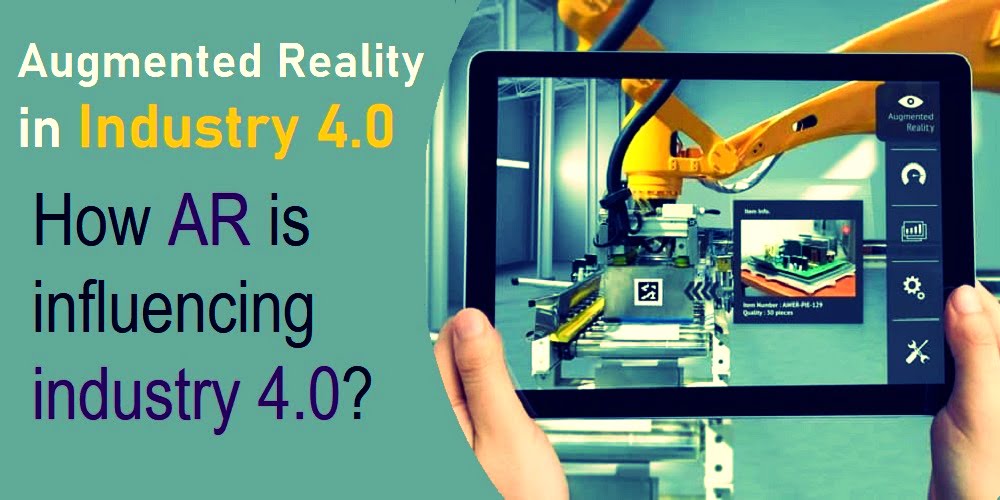AR – Augmented Reality in Industry 4.0: Augmented reality is an integral part of Industry 4.0, as it facilitates processes in industrial automation and enables operators to easily and visually access digital information and overlay that information with the surrounding environment.
The adoption of augmented reality in industry 4.0 supports technicians in their real work environment and enables workforces to be more efficient in increasingly complex production processes.
Let’s look at how augmented reality (AR) can support Industry 4.0 and what is the key role of AR in Industry 4.0?

How Augmented Reality (AR) can Support Industry 4.0?
New technologies such as augmented reality, artificial intelligence, and edge computing play a key role in the success of Industry 4.0, breaking the existing lifestyle, manufacturing, and business models, and highlighting the power of new technologies everywhere. As far as manufacturing is concerned, these new technologies will reshape the industrial manufacturing industry.
Augmented reality is a kind of imaging technology that allows the interaction between the virtual world and the physical world and penetrates into industrial manufacturing.
Smart manufacturing is the intelligent manufacturing of products, processes, and services. AR technology is used in the production and R&D process of the product life cycle, which improves the efficiency of the design and tends to streamline the design. At present, AR technology is widely used in manufacturing and assembly, inspection and maintenance, and practical training.
Regarding the assembly of the production line, the process can be standardized and the data can be visualized, including graphics, animation, 3D models, etc., to ensure safe production. For industrial maintenance, the AR glasses worn by the staff can obtain equipment parameters, maintenance records, maintenance manuals, and other information, and guide the staff to perform maintenance. In addition, experts can use AR technology for remote work guidance, which not only improves work efficiency, but also reduces human errors, etc., and ensures flexible maintenance work.
In order to meet the goals of Industry 4.0, many manufacturers strive to simplify their processes so that they can quickly produce consistently high-quality products.
Intelligent manufacturing relies on the cooperation between humans and leading technologies, and this cooperation flourishes with the improvement of user experience. Augmented reality complements the user interface that represents reality and data with useful information in the form of visual, audio or tactile signals.
Real-time information provided by AR technology can help manufacturers improve quality, efficiency, and safety. Visual, audible and tactile alarms enable employees to be aware of the surrounding environment and issue timely alarms to improve safety. The advantages of AR in inspection and quality control are particularly obvious when training newbies and inexperienced employees, but AR still provides important practical tools for experienced workers.
With the advancement of augmented reality technology hardware and software, as well as the substantial increase in data processing capabilities, more and more manufacturing companies have begun to use AR technology to improve production and management efficiency.
As the next important computing platform, from design to production, to quality control, to post-maintenance and employee training, augmented reality technology is strongly promoting the transformation of modern manufacturing and adding impetus to the realization of Industry 4.0.
Read here: The 9 Pillars of Industry 4.0: Explained
Key Role of Augmented Reality in Industry 4.0 Environment
Augmented reality is one of the key technologies in Industry 4.0 that has a major impact on industrial automation and intelligent manufacturing. Below is the main role of augmented reality in Industry 4.0.
Industrial Design
The traditional industrial design stage mainly includes five main steps: understanding customer needs, converting requirements into technical inputs, providing multiple solutions, choosing feasible solutions acceptable to customers and transferring the determined solutions to the manufacturing team.
This traditional design process is very complicated and requires a lot of energy and time to determine the best feasible product for the client company.
The integration of augmented reality into the design and development stage can simplify the traditionally cumbersome process, enhance interaction with customers, and make product design more in line with customer needs.
Assembly Manufacturing
As we all know, in the industrial production process, many links still require manual operation by workers. Especially in the assembly process, the cycle time of assembly depends on the skill proficiency of the operators, especially the complicated large-scale machinery and equipment such as airplanes and automobiles.
For example, an aircraft has a large number of complex electronic circuits. In the wire harness assembly composed of thousands of wires, assembly engineers must follow the function manually to work. This is a time-consuming and labor-intensive process that greatly affects the construction period. Aircraft manufacturers can use AR glasses to simplify the assembly process.
With the increased use of Industry 4.0 technologies in the manufacturing process, augmented reality is gaining momentum across different stages of the product lifecycle. Augmented reality technology can benefit machine operators in many manufacturing tasks and provide work instructions for manual assembly.
Quality Inspection
Quality inspection is an important link to ensuring that factory products meet all requirements. Traditional production requires a large list of checkpoints to complete, and quality inspectors are responsible for the delivery of the final product.
Therefore, the quality of the products received by customers not only depends on the product quality control during the production process but also depends on the accuracy of the quality inspection process.
AR is one such amazing technology that you can take advantage of to ensure quality, improve the inspection process, and thus reduce time to market.
AR technology provides an interactive platform for quality control, you can examine detailed information such as product dimensional accuracy, tolerances, and surface finish displayed in real-time so that quality inspectors can easily perform complex tasks.
System Maintenance
Every industry needs regular maintenance of various equipment to ensure the normal operation of daily production, but the maintenance of related equipment in the manufacturing industry is far more complicated than that of household consumer electronics, and the requirements for maintenance personnel will also be very high.
Because they must be fully familiar with the structure and functions of the equipment, and refer to a large number of technical charts and hundreds of pages of service manuals.
The equipment manufacturer is using augmented reality technology to assist maintenance and repair work. Through AR technology, maintenance personnel can view equipment problems on smartphones, tablets, and even AR glasses, and complete maintenance work through interactive visual operations.
Staff Training
Training is an important way for companies to acquire high-quality employees. Companies usually invest a lot of time and money in various training activities to improve the skill quality and stability of their employees.
Compared with traditional paper training or supervised training methods, AR technology can make training methods interactive; break location restrictions and realize remote training; and can also ensure the personal safety of employees during training.
Some automotive technology suppliers have developed an augmented reality application that digitizes employee training plans, manuals, and other content, and provides employees with text, images, animation, audio, video, and other content. The AR interactive interface allows employees to use simple gestures to zoom in and rotate content.
Conclusion: How Augmented Reality Fits into Industry 4.0
Augmented Reality (AR) plays a pivotal role in Industry 4.0, the fourth industrial revolution. Unlike Virtual Reality (VR), which immerses users in digital environments, AR overlays digital information onto the real world. This transformative technology enhances processes across various sectors, including product development, manufacturing, logistics, marketing, customer service, and employee training. By bridging the gap between the physical and digital realms, AR improves quality, productivity, and user interactions. Forward-thinking companies are already leveraging AR throughout their value chains, making it a key interface between humans and machines.
The application of augmented reality in the manufacturing industry is still in its infancy. With the maturity of related technologies, the further reduction of costs, and the integration and application of 3D printing, digital twins, industrial Internet of Things, predictive analysis, machine learning, computer vision, and other technologies, augmented reality will bring more changes to the modern manufacturing industry (industry 4.0).
In the future, as AR technology continues to mature, you can integrate it with new technologies such as 5G, the Internet of Things, big data, and artificial intelligence to promote the implementation of intelligent manufacturing.
Read Also:



